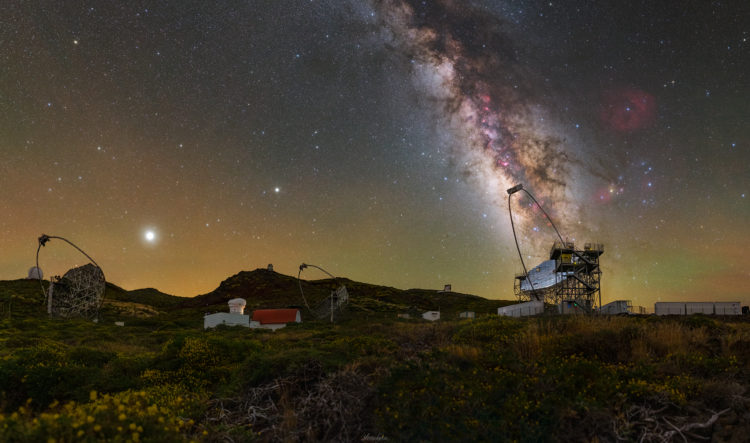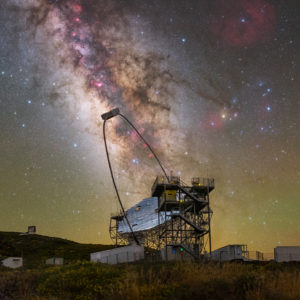Faster than Light
Description
Human eyes see just a tiny fraction of the universe. If we want to go further, we can extend our vision thanks to the different telescopes. For scientists – each spectrum of electromagnetic radiation is interesting. Like gamma-rays – with much more powerful photons, than the visible light spectrum. Nothing generated on Earth comes close to the energy of the highest energy gamma rays. Fortunately for Earth’s habitants, they actually don’t make their travel up to the Earth’s surface. Our atmosphere is interacting and scattering the radiation to subatomic particles. These energetic particles move faster than the light in the air (not faster as light itself – that’s impossible), and create a “photonic boom”. It’s called Cherenkov light – named by Pavel Cherenkov. With powerful instruments, we could reveal the mystery of dark matter, observe remnants of supernova explosions, binary systems, active galactic nuclei, and clusters of galaxies. For this purpose, the largest and most sensitive ground-based observatory is in the process to build. And it will be called CTA – Cherenkov Telescope Array Observatory. To cover the full celestial sphere, one observatory will be located in the Southern hemisphere – in the ESO Paranal observatory in the famous Chilean desert Atacama. The second base will be located above the equator – in La Palma Canary Island with three types of telescopes -small (70 pc), medium (25 pc), and large-size (4 pc). North base is supposed to come into operation in 2024 and it’s likely it will help scientists to penétrate into new discoveries.
In the photograph, we can see the 23m-diameter prototype telescope built in the La Palma IAC Roque de Los Muchachos observatory called LST1 – Large-Size Telescope pointing directly to the Milky Way core, where the Sagittarius A black hole exists. It’s just a symbolic intention of the photographer because black holes produce gamma-rays. LST1 is surrounded by MAGIC telescopes, from which technology it’s developed. Two bright objects are Jupiter and Saturn and colors above the horizon are caused by airglow. Source: cta-observatory.org
In the photograph, we can see the 23m-diameter prototype telescope built in the La Palma IAC Roque de Los Muchachos observatory called LST1 – Large-Size Telescope pointing directly to the Milky Way core, where the Sagittarius A black hole exists. It’s just a symbolic intention of the photographer because black holes produce gamma-rays. LST1 is surrounded by MAGIC telescopes, from which technology it’s developed. Two bright objects are Jupiter and Saturn and colors above the horizon are caused by airglow. Source: cta-observatory.org
Technical detail: Photo composite. A blend of multiple exposures.
Info
Share


comments (0)